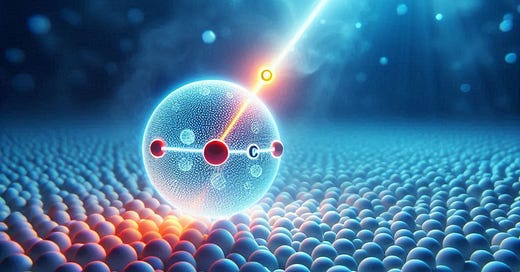CO2 and Milankovitch Cycles
How much faith do you have in scientific models and the projections claimed by the proponents of those models? As an opponent of the Climate Change Crisis Theory, my faith is shaky.
CO2
Question:
If a greenhouse farmer feeds CO2 into her greenhouse to increase its concentration from 420 parts per million of atmospherics gases to 2000 PPM, by how many degrees will the temperature within the greenhouse rise? Assume 24 degrees Celsius as the temperature at midday under full sunlight prior to prior to adding the CO2.
Answer.
Less than one might imagine. Proponents of the Climate Change Crisis Theory worry about a rise in the global temperature of 1.5 degrees Celsius over the next eight decades if the CO2 PPM continues to rise at the same pace as the past two centuries. The PPM of CO2 at the beginning of the Industrial Revolution was estimated as ~270 PPM which is 150 PPM less than today. At about 75 PPM per century, one might assume that the CO2 concentration might reach 300 PPM by the year 2100, far less than the 2000 PPM that greenhouse farmers pump into their greenhouses to increase plant photosynthesis and crop yield.
The greenhouse farmer would experience small temperature increases, only 2 to 3 degrees Celsius, at CO2 concentrations of 2,000 PPM.
BING Copilot explains:
The relationship between the intensity of sunlight and the amount of energy absorbed by a CO₂ molecule is not strictly linear. Here's why:
1. Absorption Saturation: CO₂ molecules absorb infrared radiation at specific wavelengths. Once a CO₂ molecule absorbs a photon of infrared radiation, it becomes excited and vibrates. However, there is a limit to how much energy a single CO₂ molecule can absorb at any given time. Beyond this point, additional increases in sunlight intensity won't proportionally increase the energy absorbed by that molecule¹².
2. Beer-Lambert Law: The absorption of light by a gas follows the Beer-Lambert Law, which states that the absorption of light is proportional to the concentration of the absorbing species and the path length of the light through the gas. This relationship is exponential rather than linear, meaning that as the concentration of CO₂ increases, the amount of light absorbed increases logarithmically¹.
3. Spectral Lines: CO₂ absorbs infrared radiation at specific wavelengths (spectral lines). The intensity of sunlight at these wavelengths can vary, and the absorption efficiency depends on how well these wavelengths match the absorption bands of CO₂².
In summary, while there is a relationship between sunlight intensity and energy absorption by CO₂, it is influenced by factors such as absorption saturation and the Beer-Lambert Law, making it more complex than a simple linear relationship. 🌞🌍
¹: [Center for Science Education - Carbon Dioxide Absorbs and Re-emits Infrared Radiation](https://scied.ucar.edu/learning-zone/how-climate-works/carbon-dioxide-absorbs-and-re-emits-infrared-radiation)
²: [MIT Climate Portal - How do greenhouse gases trap heat in the atmosphere?](https://climate.mit.edu/ask-mit/how-do-greenhouse-gases-trap-heat-atmosphere)
Source: Conversation with Copilot, 2024-11-17
(1) 8.2: The Light-Dependent Reactions of Photosynthesis. https://bio.libretexts.org/Bookshelves/Introductory_and_General_Biology/General_Biology_1e_%28OpenStax%29/2%3A_The_Cell/08%3A_Photosynthesis/8.2%3A_The_Light-Dependent_Reactions_of_Photosynthesis.
(2) Khan Academy. https://www.khanacademy.org/science/ap-biology/cellular-energetics/photosynthesis/a/light-dependent-reactions.
(3) Carbon Dioxide Absorbs and Re-emits Infrared Radiation. https://scied.ucar.edu/learning-zone/how-climate-works/carbon-dioxide-absorbs-and-re-emits-infrared-radiation.
(4) 25: Light and Photosynthesis - Biology LibreTexts. https://bio.libretexts.org/Courses/Gettysburg_College/01%3A_Ecology_for_All/25%3A_Light_and_Photosynthesis.
(5) 11.2 Light and Photosynthesis – The Science of Plants. https://open.lib.umn.edu/horticulture/chapter/11-2-light-and-photosynthesis/.
Milankovitch Cycles
For 100 years, three Earth orbital cycles have been known and studied by scientists. These explain long term changes in Earth’s climate and have been accepted by most scientific experts as undeniable fact.
Controversy remains regarding how these cycles affect climate over shorter periods, decades or centuries for example.
Scientists create models for predicting future scenarios. Assumptions must be made to create these models because the future in unknown and the number of the variables must be reduced to shrink the complexity so accommodate the limitations of current modelling methods and technologies.
Milankovitch Cycles explained.
Two NASA links follow. The first informs what they are in simple language; the second explains why scientists believe that the Milankovitch Cycles are not the “whole story” to explain the rationale behind the Climate Change Crisis Theory. To their credit, the scientists admit how much they don’t yet understand about our planet and how dependant they are on models to forecast the future.
Unsettling Science.
When it was first released, I read Unsettled: What Climate Science Tells Us, What It Doesn’t, and Why It Matters, by Steven E. Koonin.
It is generally the first book I recommend to advocates of the Climate Change Crisis Theory. One one has accepted my recommendation so far that I know of. Pity.





I have zero faith in the falsified science co2 models! You are the carbon these corrupted puppet scientists of the elites want to get rid of.
JUST WOW GENE.... Great research